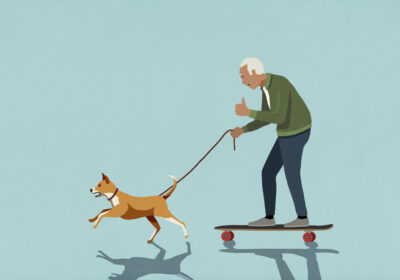 It’s common to wonder whether talking to yourself is “normal.” Let me be the first to tell you—it’s what got me through the pandemic.
It’s common to wonder whether talking to yourself is “normal.” Let me be the first to tell you—it’s what got me through the pandemic.
Three years ago following a routine sinus surgery, I woke up to blinding head pain. My surgeon assured me it was temporary, but months passed and the pain endured. I quit my job and moved in with my parents, who took me to countless specialists. Eventually, I was diagnosed with chronic daily headache, a condition defined by experiencing 15 or more headache days a month, according to the Mayo Clinic.
Throughout the next year I tried several treatments, from Botox to nerve blocks and even experimental medication. While marginally helpful, nothing really worked until my longtime psychiatrist suggested somatic therapy.
Somatic therapy is quite different from more commonly known forms of therapy, like cognitive behavioral therapy or dialectical behavioral therapy, in that it aims to treat symptoms of chronic and post-traumatic stress with exercises that direct the patient to focus on internal sensations, like tension, pain, or tightness. In doing so, somatic therapy is meant to explore and bridge the connection between body and mind.
Prior to starting therapy, that connection, for me, was nonexistent. Whether overloading my schedule or not taking care of a cold, I had ignored my body my entire life. Like many other somatic therapy patients, I started my journey by doing mindfulness exercises to learn to be more aware of my body. My therapist taught me to pendulate by shifting focus between an area of pain to a more comfortable area on my body. I also practiced visualizing my pain as a wall and dismantling it brick by brick.
At first, none of these coping mechanisms seemed to work. I struggled with them for six months and inevitably felt frustrated. “You can’t undo 20 years of behavior in a few months,” my therapist reminded me. “How can you expect your body to see you as a friend when you treat it like something to be crossed off your to-do list?”
Then she suggested something new: In order to actually befriend my body, I had to really, truly, treat it like a friend. And that involved speaking to it—having actual conversations with my body. “Approach it like any new relationship,” my therapist said in total seriousness. “Try to ask questions to get to know it better.”
So, I started talking to myself. Out loud.
While it may sound strange, asking yourself questions is actually a common practice in somatic therapy, used to clarify awareness of what is happening in the body. But according to my therapist, not everyone is told to simply talk to themselves. My therapist suggested this as part of our somatic therapy to enable me to further develop that mind-body awareness in a way I could more easily understand.
 At first, I was reluctant. I asked my body audibly, “How are you feeling?” when my migraines worsened. Often, my body would flood with anxiety or freeze up with stress. When that happened, I’d ask, “What do you need in order to feel more relaxed?” I would wait and listen, then act on what my body “said” back to me. If my body felt tired, I would nap. If I was anxious, I would meditate. If I needed more information about what my body needed, I asked follow-up questions.
At first, I was reluctant. I asked my body audibly, “How are you feeling?” when my migraines worsened. Often, my body would flood with anxiety or freeze up with stress. When that happened, I’d ask, “What do you need in order to feel more relaxed?” I would wait and listen, then act on what my body “said” back to me. If my body felt tired, I would nap. If I was anxious, I would meditate. If I needed more information about what my body needed, I asked follow-up questions.
I used this “conversation” technique sparingly for a year and a half before the pandemic, but it became an invaluable tool when lockdown began in March 2020. The first week of quarantine, debilitating migraines and anxiety made it impossible for me to work. To cope, I began talking with my body for 30 minutes up to six times a day. To others, even patients of somatic therapy, this may seem like a lot. However, when I expressed this concern to my therapist, she said that if talking to myself was making me less anxious, I should do it as much as I thought was needed. (Granted, I was under her regular care—if you’re dealing with anxiety, depression, or a chronic condition, it’s best to practice therapeutic techniques in tandem with the guidance of a mental health care professional.)
From my “conversations,” it was clear that my body was stressed and anxious about the reality of my new situation; that I desperately needed more time to ground myself each day. So I started meditating twice a day for 30 minutes to an hour, and taking daily long walks. Within two weeks, I was able to “talk” with my body less, and lead an uninterrupted life more.
Yes, this all might sound extremely straightforward—and it’s a technique almost anyone can try for themselves. But before you dive into this conversation exercise, know that mental health professionals still recommend you practice somatic therapy techniques under the guidance of a therapist if possible.
“People appear to be following the suggested techniques, but there’s a high chance they’re doing it wrong,” Sharlene Bird, Psy.D., a clinical instructor at the Department of Psychiatry at the NYU Grossman School of Medicine and a psychologist and somatic experiencing practitioner, tells SELF. “If you don’t have the proper language or guidance from a professional,” Dr. Bird notes, “the process can become confusing, or even triggering.”
However, that doesn’t mean you can’t employ elements of somatic therapy practices—like that of basic mindfulness—on your own. “Somatic therapy is all about focusing on an awareness of your body, particularly your nervous system,” Dr. Bird tells me. Mindfulness is used in somatic therapy to “help you track what is happening in your body, which gives you a wealth of information. By being attuned to your body, it allows you to be fully present and notice how your body responds.”
If you’d like to try talking to yourself, Dr. Bird recommends a simplified version of the conversation technique. At the same time each day, ask yourself, How is my body feeling? Does it feel energetic, fatigued, relaxed? Then note your response. Practicing the simple act of noting, Dr. Bird says, “allows your body to recognize how you are feeling instead of repressing it.” Giving that feeling space in your body makes it feel less urgent or obstructive and allows you to move on from it.
Dr. Bird also emphasizes that it’s important to be patient with yourself along the way. “We aren’t taught to feel through our bodies,” she says. “An exercise like this may seem foreign at first because it is hard to explain the connection to your body, even if you have thousands of words. You have to experience it.”
Even with professional help, it took months for me to feel any connection with my body and even longer until that relationship felt natural. Someone else in somatic therapy might have a completely different timeline. “For my patients,” Dr. Bird notes, “the range of time it takes for therapy to ‘click’ is extensive, from one session to several years. It completely depends on the person and what they are trying to work through.”
This is all to say, be kind to yourself when building your mind-body connection, especially through exercises like these. Trying to connect to yourself can be especially difficult when we’re (still!) living in such abnormal times. If a practice like this feels odd for a while—or like it doesn’t work at all—that’s more than okay. There are other ways to get in touch with your body through mindfulness or meditation. If it’s feasible for you, therapy is always a great place to start too. It’s enlightening to realize how much our bodies know about us—and how much they may be able to help us when we take the time to listen.
Original article here





